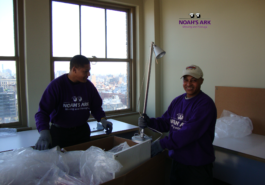 A Positively Moving Experience
A Positively Moving Experience

CHILDPROOFING YOUR MOVE

If you have a small child, it’s of primary importance to childproof your home as soon as possible after you move in. Accidents are more likely to happen at newly moved-into homes if you don’t make the creation of a safe environment for children your priority. If you follow this list of essential tips, you can quickly prime your home to be a safe space for children.
Utilize Gates
Baby gates essentially keep children out of trouble. Placed in specific, strategic areas like stairwells, kitchens, and front/back doors, these gates can prevent children from wandering out when the door is open. Make sure that these gates can be properly latched and that they function correctly. Also important is your ability to quickly open and close them, because if they are difficult to operate, the likelihood that your household will be too lazy to utilize them increases.
Guard all Windows
Make sure that all windows are closed and locked in rooms that aren’t being used – if you need fresh air, open the top part of the window. Install guards on all windows in your new home – or install devices that only allow them to open a few inches. If the window is crank operated, unscrew it off and keep it in another area so that your child can’t play with it when you’re not watching.
Keep all cords tightly organized
Make sure that any dangling cords from blinds or electronics aren’t hanging where children can get tangled in them. Ideally, don’t use any window coverings with cords, and if your home has them, but them or wind them up to make them shorter and thus, safer.
Dishwasher Vigilance
It’s always best to keep the entire kitchen inaccessible to little children, but if you can’t do that, make sure the dishwasher can be locked – and that you run it as soon as you add the detergent, which is a toxic ingestible.
Secure Heavy Objects
Make sure heavy objects like televisions and bookshelves are stable, and cannot fall over if they are bumped. I recommend bolting the television to the wall and moving any other large objects against the wall as close as possible to stabilize them. If you’re stacking items on a table, place the heaviest objects on the bottom to foster extra stability.
Lock all dangerous items
Lock up any cleaners or ingestables in cabinets with gates that are childproof. Another possibility is to keep them as high up as possible where your child can’t reach them – however this is never as good as locking them up, as they might fall down, and children have been known to improvise ways of climbing onto tabletops to access high up areas.









